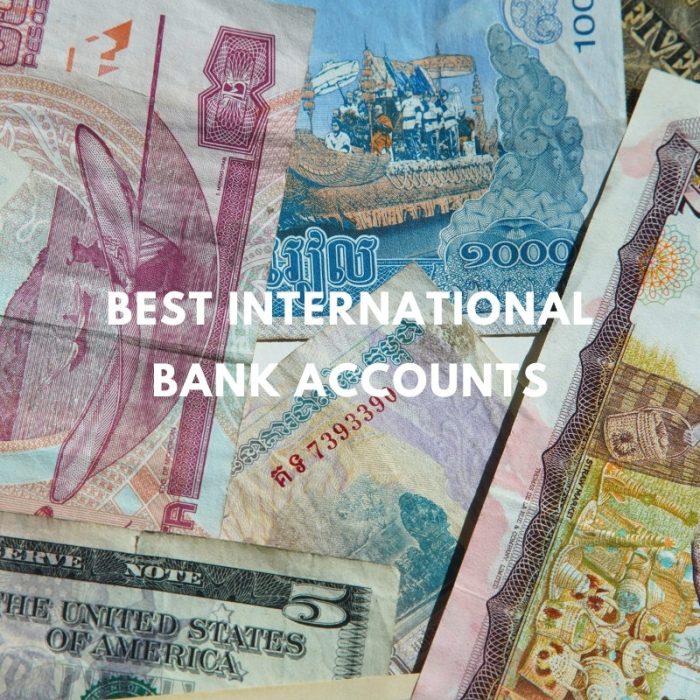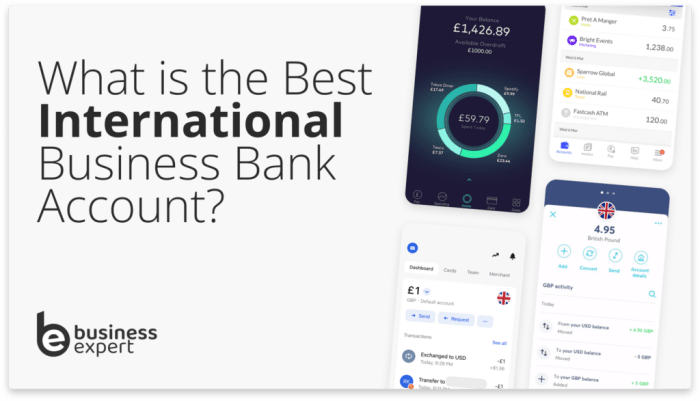Best International Bank Account selection is crucial for navigating global finances. Choosing the right account depends heavily on individual needs, whether you’re a frequent traveler needing seamless access to funds or a business owner managing international transactions. Factors like fees, accessibility, security, and currency exchange capabilities all play a vital role in determining the best fit. This guide explores these key aspects, empowering you to make an informed decision.
From comparing different account types – checking, savings, and multi-currency – to understanding the intricacies of fee structures and the importance of robust security measures, we’ll demystify the process of selecting an international bank account. We’ll analyze various features offered by different institutions, helping you identify the best match for your specific financial goals and international activities.
Defining “Best”

Choosing the “best” international bank account is inherently subjective, depending heavily on individual needs and priorities. There’s no single perfect solution; the optimal choice varies significantly based on a person’s financial situation, lifestyle, and future plans. Understanding the key factors influencing this decision is crucial for making an informed choice.
Factors Influencing International Bank Account Selection
Five key factors consistently emerge as paramount considerations when individuals select an international bank account. These are: fees and charges associated with transactions and account maintenance; the accessibility of ATMs and branches globally; the range and quality of online and mobile banking services; the level of customer support offered; and the security measures implemented to protect account holders’ funds. A thorough evaluation of these aspects is essential before committing to any particular institution.
The Role of Individual Financial Goals
Individual financial goals significantly shape the definition of the “best” international bank account. For instance, a retiree living abroad might prioritize low fees and convenient access to funds, while a global entrepreneur might require sophisticated international payment capabilities and robust business banking features. A student studying overseas, on the other hand, may focus on ease of use and affordability.
Therefore, the ideal account is always context-dependent and directly tied to the individual’s unique financial objectives.
Comparing the Needs of Travelers and Business Owners
Frequent travelers and business owners, while both benefiting from international banking, have vastly different requirements. Frequent travelers primarily need convenient access to cash globally, minimal fees for foreign transactions, and reliable online banking for managing funds while on the move. Business owners, conversely, often need more complex services such as international wire transfers, multi-currency accounts, and potentially merchant services integration.
Their choice will be driven by the need for efficient and secure management of business finances on an international scale.
Comparison of International Bank Account Features
The following table compares features of three hypothetical international banks – Bank A, Bank B, and Bank C – to illustrate the variations available. Remember that actual fees and services can change, so it’s vital to verify directly with the bank before making a decision.
| Feature | Bank A | Bank B | Bank C |
|---|---|---|---|
| Monthly Fee | $10 | $0 (with minimum balance) | $15 |
| ATM Withdrawal Fee (International) | $5 | $3 | Free (within network) |
| International Transfer Fee | $25 + 0.5% | $30 + 0.25% | $20 + 0.75% |
| Online Banking Capabilities | Basic | Advanced (multi-currency) | Advanced (with budgeting tools) |
Account Features and Services: Best International Bank Account

Choosing the best international bank account hinges significantly on understanding the features and services offered. Different account types cater to varying needs, and a thorough assessment of these features is crucial for making an informed decision. This section will delve into the advantages and disadvantages of common account types, highlight essential features, and showcase innovative services offered by leading international banks.
Account Types: Advantages and Disadvantages
International banks typically offer a range of account types, each with its own set of benefits and drawbacks. Understanding these differences is key to selecting the account that best aligns with your individual financial goals and transaction patterns.
- Checking Accounts: These accounts provide easy access to funds through debit cards and online banking. Advantages include convenience for everyday transactions and often competitive interest rates on balances above a certain threshold. Disadvantages may include lower interest rates compared to savings accounts and potential monthly maintenance fees if minimum balance requirements are not met. Many international banks offer features such as international money transfers at competitive rates as part of their checking account packages.
- Savings Accounts: Designed for accumulating funds, these accounts generally offer higher interest rates than checking accounts. The primary advantage is the potential for earning returns on your savings. However, access to funds might be more restricted, with limitations on the number of withdrawals per month. Some international banks offer tiered interest rates, increasing returns based on the balance held.
- Multi-Currency Accounts: These accounts allow you to hold and manage funds in multiple currencies, eliminating the need for currency conversions each time you transact internationally. The main advantage is the avoidance of exchange rate fees and the convenience of managing finances across borders. A potential disadvantage is the complexity of managing multiple currencies and the possibility of higher account maintenance fees compared to single-currency accounts.
For example, a multi-currency account could simplify managing payments to suppliers in different countries, reducing administrative burden.
Essential Features of an International Bank Account
Several key features significantly enhance the functionality and convenience of an international bank account. Prioritizing these features during your selection process can greatly improve your banking experience.
- Online and Mobile Banking: Access to your account anytime, anywhere, via secure online and mobile platforms is crucial for managing your finances efficiently. This allows for real-time monitoring of balances, transaction history review, and convenient fund transfers.
- International Money Transfers: The ability to send and receive money internationally at competitive exchange rates is a cornerstone of any international account. Look for banks with transparent fee structures and efficient transfer times.
- Debit and Credit Cards: Access to globally accepted debit and credit cards simplifies payments in various countries, providing a convenient alternative to carrying large amounts of cash.
- Customer Support: Reliable and readily available customer support, preferably in multiple languages, is essential for resolving issues and addressing queries promptly. This includes both online and phone support channels.
- ATM Access: A wide network of affiliated ATMs globally ensures convenient cash withdrawals without incurring excessive fees.
Innovative Banking Services
Leading international banks are constantly innovating to enhance customer experience. Examples include:
- Biometric Authentication: Using fingerprint or facial recognition for account access enhances security and streamlines the login process.
- Open Banking APIs: Allowing third-party applications to access account data securely enables personalized financial management tools and streamlined budgeting features.
- AI-Powered Chatbots: These tools provide instant customer support, answering common questions and resolving simple issues efficiently, freeing up human agents for more complex queries.
Security Measures, Best International Bank Account
A reputable international bank should prioritize robust security measures to protect customer funds and data.
- Two-Factor Authentication (2FA): Adding an extra layer of security beyond passwords, requiring a code from a separate device for login.
- Fraud Monitoring and Alerts: Proactive systems that detect suspicious activity and alert customers immediately to potential threats.
- Data Encryption: Protecting sensitive customer data through robust encryption protocols during transmission and storage.
- Regular Security Audits: Independent audits to ensure the bank’s security systems are up-to-date and effective.
- Secure Online and Mobile Platforms: Employing advanced security technologies to prevent unauthorized access to online and mobile banking platforms.
Ultimately, finding the Best International Bank Account hinges on a careful evaluation of your unique financial needs and priorities. By understanding the nuances of fees, security protocols, accessibility, and currency exchange services, you can confidently select a banking partner that aligns with your global ambitions. Remember to thoroughly research and compare options before making a decision, ensuring a secure and efficient financial experience in the international arena.

